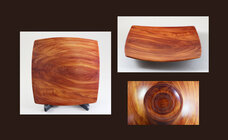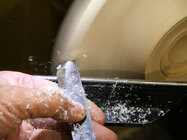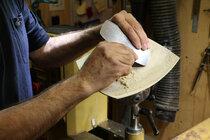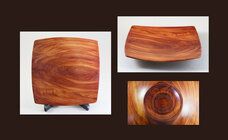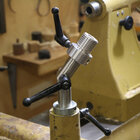Bill,
I'm sorry I missed your post before. I agree with what Odie wrote.
Made me think of a few things.
One question: is the problem needing sanding "adjustment" for smooth shape with getting a satisfactory continuous finishing cut (without high or low spots), or is it with tearout or surface roughness?
A suggestion: It might be
huge help to have someone with a significant experience look at your lighting, tools, sharpening, watch you turn. They might have useful suggestions - sometimes the cause is immediately obvious. And for surfaces where you can't easily see the surface, there are some techniques that might help.
Besides the obvious: good wood, good shaving-sharp tools, steady hands, and assuming the problem you have is with shape and surface evenness rather than tearout/surface roughness, to me the most important things are the kind of lighting, the type of tool and how it's held and moved, and where the eye is looking while turning. If it's surface roughness, it's a different problem (e.g. sanding tearout can be a losing battle).
If turning the outside of a form, face work or spindle, I often have to remind some new (and remedial turners) to not look at the tool but instead watch the upper profile. (I also have to remind to move the body, not the arms.)
Seeing the surfaceon the inside of a bowl or box while turning is more difficult but the right lighting can even help there.
As I mentioned earlier in this and another thread, I personally use special NRS and sharp hand scrapers extensively - saves me a lot of time and a LOT of sanding. With these pieces often don't need coarser than 400 grit. BTW, I do almost all sanding by hand, much with the lathe off.
For demos on my design shown below, I take several examples pieces including this one from eastern red cedar. It's admittedly a fairly soft wood but after the NRS and hand scrapers the only sandpaper needed was 600 grit. I may have to start with coarser paper, say 320, some similar pieces. Oil finish.
View attachment 67841
Here's my favorite NRS and a hand scraper in action on this design (and I was told once you can't use scrapers when turning air - not totally true). To evaluate the surface while turning and smoothing I use sight and touch.
The NRS refines the surface, the hand scrapers remove any NRS tool marks.
View attachment 67843 View attachment 67842
If the problem is making smooth, continuous passes, there is one thing I and some others I know do: When working towards the final pass, don't just hog out the wood until very close to the intended surface.
Instead, make numerous "practice" passes, sometimes trying different things. Sometimes it helps to vary the tool presentation, tool rest, lathe speed, cutting speed, tool pressure, body motion, etc. Sometimes I try completely different tools in earlier passes - a different grind or type of tool may work better for that particular chunk of wood. This method does take longer, but practicing that finishing cut as I proceed often gives me a better "final" finishing cut.
JKJ

